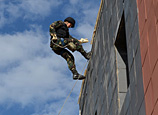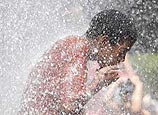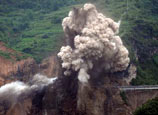
C. Defense realignment and reinforcement in response to island dispute between China and Japan
As tension kept building up in 2012 around the disputed Diaoyu Islands, Japanese military adjustment has attracted global attention. In the past, Japanese media, when reporting JSDF’s “Southwest Defense Program” and military drills on “recapturing islands”, would more or less reveal Japanese military preparation for island disputes. Yet these reports did not represent official attitude or government policy. Military-related strong statements on the dispute around the Diaoyu Islands on public occasions began with Mr. Hatoyama. When he was questioned in a hearing held in the House of Representatives on July 26th, 2012, Mr. Hatoyama replied, “if illegal activity by any neighboring country takes place within Japan’s territorial land and sea including the ‘Senkaku’ [Chinese Diaoyu] Islands, the Japanese government will respond without hesitance, exhausting all means and methods including the use of the JSDF, if necessary.” In a press conference held the following day, Japanese Defense Minister Satoshi Morimoto reiterated the position, emphasizing that what Mr. Hatayama said was necessary measures within the framework of Japanese laws. On December 26th, 2012, in a press conference right after he was elected Prime Minister, Mr. Abe promised that Japan would be committed to defending its territorial land and sea, stressing that “right now, on the seas around the ‘Senkaku’ [Chinese Diaoyu] Islands, officers and men from the Japan Coast Guard and JSDF are protecting Japan’s air and sea. Japan’s security does not rely on others; it is in danger now.” Both Mr. Hatayama and Mr. Abe, within their capacity as Prime Minister, visited Japan Coast Guard’s and JSDF’s bases in Okinawa, respectively in June 2012 and February 2013, which is rather rare among post-WWII Japanese prime ministers. On the whole, Japan’s military policies for the disputed islands are implemented in three steps: the first step is to use Japan Coast Guard, a paramilitary force, to control the situation; the second step is to step up JSDF’s preparation for medium- and low-intensity armed conflicts; the third step is to ensure U.S. military involvement and support in case the conflicts escalate out of control. At the same time, Japan has been strengthening Japan-U.S. military alliance and displaying its effectiveness, both as a deterrent to China and as a policy support to the three steps mentioned above. The evolution of Japanese military stance related to the Diaoyu Islands is the result of both the development of its southwestern defense policies and Japan-U.S. “Dynamic Defense Cooperation” in the context of U.S. strategic rebalance amid growing dispute over the Diaoyu Islands around mid-2012. The Japanese government slipped further in the direction of armed conflict under the Hatoyama administration and the Abe administration that followed. As a result, military deployment, equipment upgrading, military drills and construction of military facilities have been sped up. Specific measures include: pushing forward Japan-U.S. Dynamic Defense Cooperation focusing on the Southwest, reinforcing F15 fighter wing based in Naha Air Base, considering transferring the Shimogishima Airport to military use, deploying E-2s and E-767s in Okinawa on a regular basis, studying the possibility of deploying a second X-band early warning radar in the Southwest or other locations, initiating revision of the Guidelines for Japan-U.S. Defense Cooperation, fielding PAC-3 missiles on “Southwestern islands” under the pretext of guarding against DPRK’s missile threats, discussing whether to purchase AAV-7 and to deploy V-22 Osprey cargo helicopters, considering the establishment of the Japanese version of Marines Corps, etc. In addition, Mr. Abe also asked the Defense Ministry and relevant agencies to revise in advance the 2010 NDPG and MTDP, to work out comprehensive defense doctrines for retaking islands through joint operations, and to study the possibility of introducing U.S. Global Hawks to enhance surveillance and reconnaissance of the Diaoyu Islands. He also asked them to study the feasibility of building 10 more 1,000-ton patrol vessels for Japan Coast Guard and reorganizing its branch in Naha into Senkaku Exclusive Force composed of 600 troops and 12 patrol vessels. All these are interpreted in Japanese media as measures intended to enhance surveillance and reconnaissance of the Diaoyu Islands and responding to Chinese military “threats”. Although they are not meant to provoke China into military actions, they have undoubtedly complicated and endangered the situation in which accidents might be triggered, and the dispute that already existed might escalate out of control.
In 2012, the three trends of development in Japan’s security policies have negative implications on both regional strategic balance and China’s security environment. Japan usually interprets “defense normalization” as an internal issue; however, in the specific historical context and guided by the rightist ideas and narrow nationalism, “normalization” will inevitably cause concern and anxiety. In terms of national politics, “normalization” reveals itself in Japan’s attempts to revise the constitution and outgrow the postwar regime for military buildup and involvement in overseas military activities; in terms of diplomatic relations, it is seen in Japan’s pursuit for closer Japan-U.S. military alliance amid closer bilateral relations, exploitation of “China Threat”, and a strategy of military buildup aimed at curbing and containing China. To that end, Japan’s “normalization” efforts have been involving more and more military aspects, thus poisoning the security relations between Japan and China.
【11】 【12】 【13】 【14】 【15】 【16】 【17】


















 Elder couples celebrate golden wedding anniversary in Hangzhou
Elder couples celebrate golden wedding anniversary in Hangzhou


![]()
